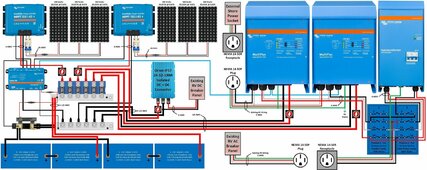I am not a fan of breakers on the battery side of the system. A properly sized fuse and a battery switch is a more reliable solution, IMHO. Victron sells 275 amp battery switches for about $35 - put one on each battery feed in place of the 58V 200 amp breaker in your diagram. If you need to take a battery out for some reason you can still have the other battery in place and working. FWIW I also have two battery switches between my bus bar and my two Multiplus units. Not having to disconnect cables when working on a system is very handy - especially in tight quarters.
If I were you I'd look at saving some cash by using a more appropriately sized MPPT. A 150/100 is way overkill for your proposed solar array. Unless you plan to add a large number of panels I'd consider a more moderately rated MPPT.
At Current Connected the 150/100 MPPT is $516.30. It can deliver a whopping 5,800 watts @ 48VDC. The 150/35 MPPT is $184.45 and it can deliver 1,800 watts @ 48 VDC. Both solutions can deliver way more power than your proposed solar array is capable of generating.
I see you haven't come up with a 12VDC power solution for the RV. It isn't the most efficient method but for starters you can just leave your existing 120VAC to DC converter in place and let the MP-II power it like shore power does. Are you keeping a 12VDC battery for things like the tongue jack, stabilizers, etc.? Getting a 48VDC to 12VDC converter that has serious ampacity is a trick. My RV system is 24VDC so I used a Victron Orion 24-12 100 amp unit for the DC power side. It is way overkill but I didn't do enough research before I started buying parts.
Current Connected has the Victron Orion-TR 48/12 DC-DC converter for $201.45. It can output 30 amps and you can parallel units for more capacity if needed. The money you save buying the 150/35 MPPT instead of the 150/100 MPPT will more than pay for the Orion !!!

As far as proper sequence for starting and stopping the MPPT, you are correct - you should shut down PV first and then remove battery power. On start up you apply battery power first and then apply PV power. From the 150/35 MPPT solar charger manual:
Page 34 - Operation
6.5. Shutdown and restart procedure
The solar charger is always active when the PV and/or the battery terminals are powered. The solar charger does not have an
on/off switch.
To shut down the solar charger, perform these steps in the prescribed order:
1. Disconnect the PV supply to the solar charger by switching the PV supply off or by removing the external fuse(s) or circuit breaker(s).
2. Disconnect the battery supply to the solar charger by switching the battery supply off or by removing the external fuse(s) or circuit breaker(s).
To restart the solar charger after it was shutdown, perform these steps in the prescribed order:
1. Connect the battery supply to the solar charger by switching the battery supply on or by inserting the external fuse(s) or circuit breaker(s).
2. Reconnect the PV supply to the solar charger by switching the PV supply on or by inserting the external fuse(s) or circuit breakers(s).




